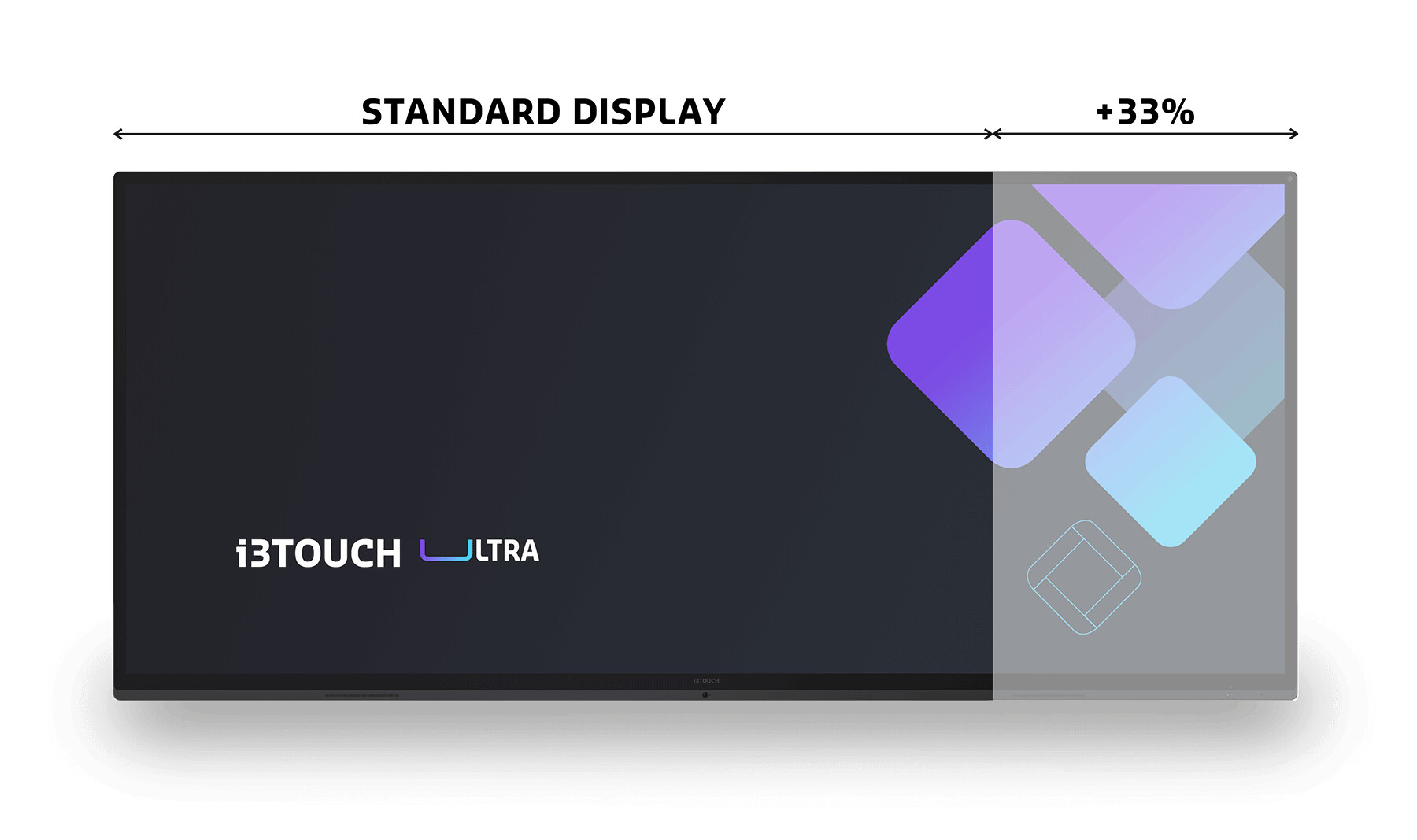



















£23,998.80*
- Resolution 5120 x 2160 5K
- Max. Brightness 450 cd/m²
- Panel type IPS
- Contrast Ratio 4,000 :1


Product information
Experience endless collaboration possibilities

The i3TOUCH ULTRA is an interactive 21:9 ultra-wide display. Analyse, visualise and work with others on complex topics and with large amounts of data; simply share the screen and work on different tasks at the same time. Engage all participants with immersive video conferencing and presentation features.
Active participation in meetings
ENGAGED TEAMS

Encourage team engagement by enabling users to share ideas, create and collaborate on content through whiteboarding, highlighting and editing. An ultra-wide display means more space for visual collaboration. You don't have to squat or stretch to work on the display (like you would with a 16:9 aspect ratio). Start your sprint, watch your retrospective or let your thoughts run free during the brainstorming session. Walk, talk and comment as you present without running out of space.
More room for multitasking

With its ultra-wide 21:9 screen ratio, the i3TOUCH ULTRA offers 33% more space for your content than a standard 16:9 display. With the extra space, i3TOUCH ULTRA is better suited to open two, three or more windows and apps side by side. Have your favourite tools always at hand, but out of the way.
Features
Capacitive touch technology (C-Sense)
Capacitive touch technology provides a very responsive and natural touch experience in a sleek, stylish design.
5K resolution
Hyper-detailed image quality and colour clarity with a 5K resolution and anti-reflective glass.
Ultra-Wide
Ultra-wide 21:9 aspect ratio for more usability and interactive freedom on a 105-inch display.
Multitasking
With the extra space, you can open two, three or more windows and apps side by side.
Exceptional clarity
Optical bonding offers many benefits: including improved colour clarity and readability, more robust texture, improved heat dissipation and the most accurate touch experience.
Convincing craftsmanship
The ultra-slim frame and aluminium accents, along with the robust finish, make for an appealing appearance.
Motion and light sensor
The combination of motion and light sensor optimises your viewing experience for all lighting conditions and balances energy consumption.
OPS slot
OPS slot
Your excel files are now no longer limited by the frame

The i3TOUCH ULTRA is handy when working with Excel files, text and media-rich content and hyper-detailed drawings or images. Meeting participants can see more information without having to constantly zoom in and out. As on any i3TOUCH display, you can annotate, save and easily share all types of content.
Ideal for project management

From helicopter views to diving into project details, i3TOUCH ULTRA will become your preferred device for project team meetings. Jira, Miro, Mural, BIM or other specialised software solutions combined with the interactive features of the display will keep everyone engaged and focused.
Adaptive image scaling

Your software is ready to use right after you connect and set up your screen. You don't need to adjust or change anything to make your programmes adapt to the 21:9 aspect ratio of your Ultra Wide display.
Improved contrast and wider viewing angles

Due to its unique aspect ratio and optical bonding technology, the i3TOUCH ULTRA delivers perfect picture quality in larger rooms, no matter where you sit. Crowded meeting room or students sitting far away? Everyone can see all the content on the screen perfectly and without light reflections.
Innovate and create together

It has never been so easy to visualise, analyse and collaborate interactively on large amounts of data or scientific content.
Create your multifunctional meeting room with the i3TOUCH ULTRA
From a scrum room to a video conferencing room, or from a client-facing room to a brainstorming room to a training facility, our versatile i3TOUCH ULTRA device lets you turn any room into a multifunctional space.
Technical data
| Name | i3 Technologies i3TOUCH ULTRA 105“ 105" Touch display |
|---|---|
| Article number | 1000028583 |
| Manufacturer SKU | 10010482 |
| Model name | i3TOUCH ULTRA 105“ |
| Brand | i3 Technologies |
| Product Type | Touch display |
| Technology | LCD |
| Panel type | IPS |
| Resolution | 5120 x 2160 5K |
| Diagonal | 105" |
| Aspect Ratio | 21:9 |
| Viewing angle - Horizontal | 178° |
| Viewing angle - Vertical | 178° |
| Contrast Ratio | 4,000 :1 |
| Max. Brightness | 450 cd/m² |
| Response time | 6.5ms |
| Inputs | 2x USB-C , 3x HDMI , 4x USB-A |
| Outputs | 1x 3,5mm Jack , 1x HDMI |
| Features | Integrated speaker , Touch screen |
| Product width | 251.1 cm |
| Product height | 112.4 cm |
| Product depth | 9.7 cm |
| Weight | 89.4 kg |
| Colour | Black |
| EEK Spectrum | A to G |
| Delivery contents | HDMI Cable , Power cable , Remote control , USB-C Cable , USB cable |
| Condition | New |
| Warranty | 24 Month |
| Warranty type | Bringin service Service and support information |
Product safety
| Person responsible for the EU |
|---|
| i3-Technologies GmbH |
| Lyrenstr. 13 |
| 44866 Bochum |
| Germany |
| info@i3-technologies.com |



